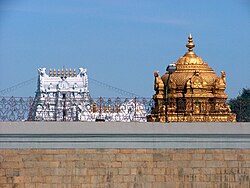
Ananda Nilayam (Abode of Happiness) is the gold-plated gopuram atop the inner sanctum of the Tirumala Venkateswara Temple. In Vaishnavism, gopurams of the inner sanctum are listed below:
Contents
- Architecture
- Construction
- Initial construction
- 1950s and 1960s renovation
- Recent activities
- Vimana Venkateswaraswamy
- References
- Sri Ranganathaswamy Temple (Srirangam), Srirangam: Pranavaakaara Vimanam (after its shape like Pranava, the sacred Om)
- Tirumala Venkateswara Temple, Tirumala: Ananda Nilayam
- Varadharaja Perumal Temple, Kanchipuram: Punyakoti Vimanam

